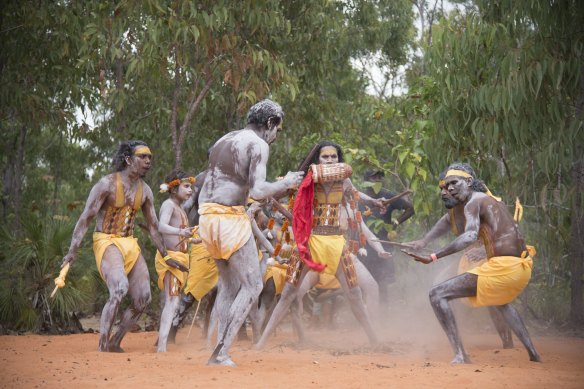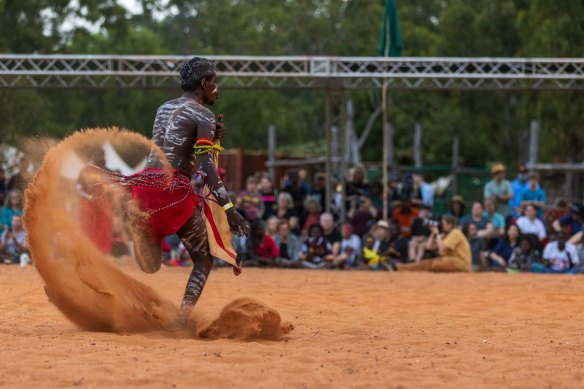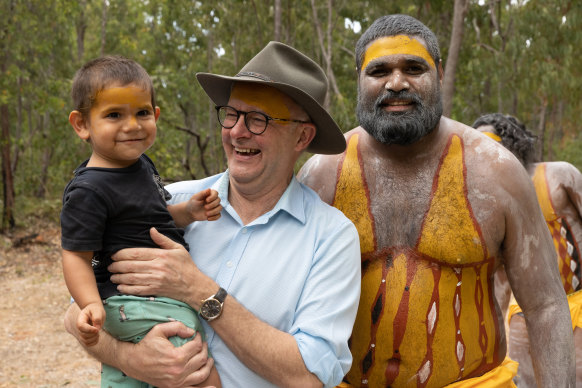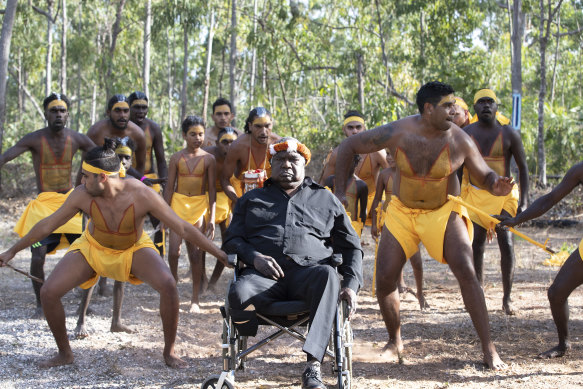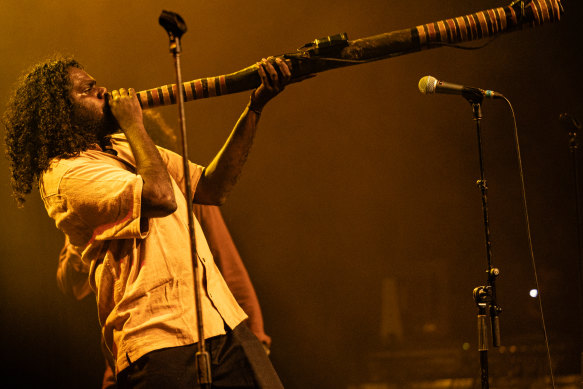‘A place where Australia comes together’: All you need to know about the Garma Festival
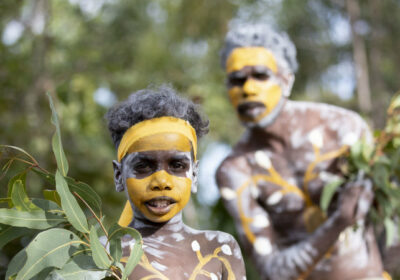
Save articles for later
Add articles to your saved list and come back to them any time.
Warning to Aboriginal and Torres Strait Islander readers: This story contains images and references to a deceased person.
This weekend, 2500 people will converge upon the remote community of Gulkala in East Arnhem Land for the annual Garma Festival, paying up to $5000 a head for a corporate pass to attend the nation’s largest and most influential First Nations event.
Ceremonial dancers perform at last year’s Garma Festival. Credit: AAP
What does Garma mean?
The term ‘Garma’ translates to “two-way learning process” in Yolngu Matha.
What is the Garma Festival about?
While the conference agenda changes each year to reflect the Garma theme, land rights, health, education, economic development and government funding regularly feature. This year’s theme is djambatj, meaning a vision of perfection or “a perfect moment in time when the balance of our world is in order”.
But the real talking point of this year’s festival will be the Voice to parliament. The date of the referendum will not be announced at the gathering, but a year after the prime minister used his 2022 keynote speech to reveal the wording he wanted in the Constitution, Garma will serve as a real-world demonstration of Indigenous authority.
Where is Garma held?
Garma takes place on the sacred Gumatj Bunggul ground in Gulkula, about 40 kilometres from the township of Nhulunbuy in the Northern Territory. The festival site was once used as a rocket-tracking station in the 1960s and, more recently, as a commercial rocket-launching facility.
The festival last year.Credit: Getty Images
Located on escarpment overlooking the Gulf of Carpentaria, the site sits within a stringybark forest where the Yolngu ancestor Ganbulapula would search for honey, using his walking stick to agitate the bees. It is also where Garrtjambal, the creator spirit in the form of a great red kangaroo, sent its life force through the land and gave Ganbulapula a staff made from the power of its tail.
Who attends the Garma Festival?
Prime Minister Anthony Albanese will be at Garma again; so too Attorney-General Mark Dreyfus, Minister for Indigenous Australians Linda Burney, Assistant Minister for Indigenous Health and Indigenous Australians Malarndirri McCarthy, and Lingiari MP Marion Scrymgour.
Northern Territory Chief Minister Natasha Fyles, and the independent member for Mulka in the NT legislative assembly, Yingiya Mark Guyula, will also be there.
Rirratjingu traditional owner and cultural curator Mayatili Marika will deliver the keynote address at this year’s Garma corporate dinner on Saturday night. Burney will also speak at the select gathering.
Prime Minister Anthony Albanese at last year’s Garma.Credit: Getty Images
Federal Opposition Leader Peter Dutton, shadow spokesperson for Indigenous Australians Jacinta Nampijinpa Price, and Arrente woman, Senator Kerrynne Liddle, have also been invited to Garma.
Dutton has declined the invitation. His former Indigenous affairs spokesman Julian Leeser will go to the festival, alongside Andrew Gee, the former National Party member who resigned from the party over its opposition to the Voice.
Chief Executive of the Business Council of Australia, Jennifer Westacott, and union leader and First Super co-chair Michael O’Connor have said they will attend. Representatives of more than two dozen corporate sponsors, including Telstra, Virgin Australia, Qantas, Woolworths Australia, Westpac, NAB, Rio Tinto, Amazon Australia, and the CSIRO are making the long trek north, too.
The prime minister has called on Dutton to attend the Garma Festival. Speaking to ABC radio’s RN Breakfast earlier this week, Albanese said: “I just say to Peter Dutton, he needs to get out of his dirt unit on these issues and go to [the] red dirt of Arnhem Land this weekend, go to Garma, which is the most significant Indigenous cultural event that occurs in this country”.
Dutton called Albanese’s radio interview a train wreck and pointed out the prime minister had repeatedly refused to answer whether he supported a treaty.
How did Garma start?
The festival has evolved from a small community barbecue led by the late brothers, Yunupingu and Dr. M Yunupingu in 1999, and continues to be organised by the Yothu Yindi Foundation. It represents the Gumatj, Rirratjingu, Djapu, Galpu, and Wangurri regional clans in Arnhem Land.
Yunupingu with traditional dancers at the 2019 Garma festival. Credit: Peter Eve/Yothu Yindi Foundation
This year’s festival will go ahead after Yunupingu passed away in April after a long illness. The festival will include a memorial to the late Gumatj clan leader, led by his family and descendants.
Djawa Yunupingu paid respect to his brother’s legacy in his first festival welcome as the newly appointed Yothu Yindi Foundation chair, describing Yunupingu as a strong leader who “stayed true to himself, and to us”.
“At Garma this year we will remember past leaders… but we will not be held back by our grief because the future is too important,” he said. “This year, grieving the loss of my brother, we are more determined than ever to stay true to his vision of Garma as a place where Australia comes together, and where we forge pathways to the future.”
Yimila Gurruwiwi of King Stingray plays the didgeridoo.Credit: Deb Pelser
How many people will attend the Garma Festival?
There has been a 25 per cent increase on numbers from 2015. Festival caterer Sodexo says its 55-member team will serve about 26,400 meals during the event from a campground pantry stocked with 4200 kilograms of meat, and 6500 kilograms of fruit and vegetables. Organisers say the bulk of the festivalgoers will be Yolngu, with around 1000 guests arriving from elsewhere.
Which famous faces will be at Garma?
Former AFL star, premiership winner and proud Anmatyerre, Maranunggu and Tiwi man Michael Long will be part of the festival’s opening ceremony on Friday.
Surf-rock band King Stingray will headline this year’s music program, which will also feature Kee’ahn, J-Milla, and William Barton among other performers.
Aswan Reid stars in Warwick Thornton’s The New Boy.
Garma Cinema (Bitja Wanga) will also offer the largest screen in Arnhem Land during the festival and will show Warwick Thornton’s latest film, The New Boy.
Who funds Garma?
The Yirrkala bark petition, presented in 1963.Credit: Yirrkala artists
In June, the federal government announced it would provide $775,000 over two years to the Yothu Yindi Foundation to host the Garma Festival.
The event brings between $10 million and $15 million to the NT economy each year. The festival employs about 160 local Yolngu directly. It supports 46 local businesses and 39 others from across the Northern Territory, organisers say.
What will be honoured at the Garma Festival?
This year’s event will also mark the 60th anniversary of the Yirrkala bark petitions.
The Yolngu people of Yirrkala presented the barks to the Commonwealth parliament in August 1963 in response to the Menzies government’s decision to remove more than 36,000 hectares from the Arnhem Land reserve to be used for mining leases, particularly bauxite mining.
The decision was made without consulting the Yolngu people. The barks were central to a lobbying campaign by the Yolngu that resulted in an inquiry and ultimately an NT Supreme Court acknowledgement of their “deep connection” to Country.
The barks are regarded as the first formal political assertion of First Nations sovereign rights in Australia and the start of the ongoing battle for land justice for Aboriginal and Torres Strait Islander people.
Cut through the noise of federal politics with news, views and expert analysis from Jacqueline Maley. Subscribers can sign up to our weekly Inside Politics newsletter here.
Most Viewed in National
From our partners
Source: Read Full Article
